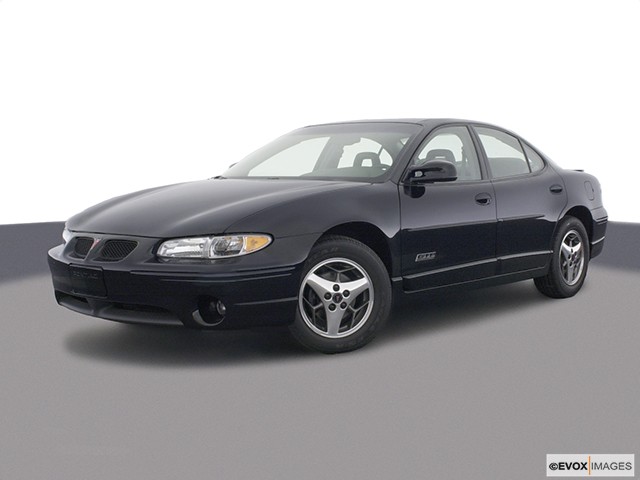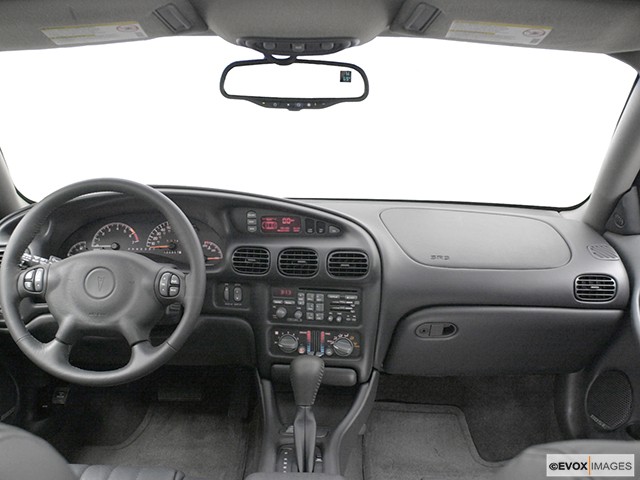The 2003 Pontiac Grand Prix is a perfect weekend car. Sporty, comfortable, with just a touch of muscle-car power in a range of V6 engines. As a daily driver it leaves a bit to be desired with modest MPG performance and a shorter-than-average life expectancy.

Is the 2003 Pontiac Grand Prix a Good Used Car?
- Overall Rating 7/10 – The 2003 Grand Prix is excellent for what it is, a sporty full-size that you’ll only take out of the garage once or twice a week. It’s a poor choice of primary vehicle.
- Interior, Comfort & Cargo 7/10 – Spacious and upscale, but the rugged suspension is a bit stiff for some drivers.
- Reliability 6/10 – It might reach 250,000 miles on the original powertrain, but it probably won’t.
- Safety 7/10 – Adequate for 2003, which is to say underwhelming and outdated for today.
- Gas Mileage 7/10 – The entry level SE gets around 27/29 miles to the gallon, city/highway, which isn’t bad for a 2003 full-size car. The more powerful GTP gets a far less impressive 17/20, which is one of the reasons this isn’t a great daily driver.
- Value 8/10 – One of the most affordable options for anyone looking to buy a zippy car to enjoy on weekends.
What Do Critics Say About the 2003 Pontiac Grand Prix?
Consumer Reports didn’t much care for the Grand Prix’s stiff suspension and heavy steering. They found the ride a bit too firm, and conclude that the car ultimately fails to deliver a sporty driving experience.
Kelley Blue Book users were far more forgiving, calling the car fun to drive, fuel efficient, and the perfect weekend-getaway car. They admit that road noise can get pretty bad, and there may be lots of little maintenance issues to worry about here and there.
Edmunds found the car fun to drive with lots of features and solid drivetrains. They felt the interior design was a little too busy and some of the trim materials looked cheap.
What Common Problems Does the 2003 Pontiac Grand Prix Have?
There is a recurring issue with smoke coming from under the hood, and potential engine fires, owing to an oil leak. This led to recalls in 2009 and 2015, but complaints still pop up as late as 2019.
Electrical issues make up a lot of the car’s National Highway Traffic Safety Administration complaints, with drivers reporting things like rear defrost and air conditioning failure.
The transmission has held up well over the years, with just four powertrain complaints on file with the NHTSA. One driver reports that they were getting hard shifts from first to second gear, with another reporting in 2005 that they had to totally replace the transmission after owning the car for just one year.
The 2003 Pontiac Grand Prix has 7 recalls and 118 complaints on file with the NHTSA, which is a surprisingly clean record for a car that appeals to the need-for-speed demographic.
How Long Will the 2003 Pontiac Grand Prix Last?
At the high end you might reach something like 290,000 miles on the Grand Prix’s original transmission, but that’s only likely to happen if you bought this car brand new. Realistically, the Grand Prix’s life expectancy runs a bit short, averaging around 220,000 miles for a used model.
RepairPal estimate an older Grand Prix to cost around $462 a year in repairs. The most expensive common fix is a new oil pump starting at $1,072.
How Is the Technology?
Entertainment technology is pretty good for a 2003 model. The entry level SE comes with a CD player and six speakers, and this is back when you might have been paying extra for a tape deck.
Safety technology is adequate considering the car’s age. Anti-lock brakes and full airbags are standard, which is about all you can really ask of a twenty year old car.
Is the 2003 Pontiac Grand Prix a Good Value?
The 2003 Grand Prix is priced to move as long as you’re not looking for a dependable daily driver. With fair market pricing starting at $1,666 for an entry level SE, and typical listing prices at around $3,031, this is one of the more affordable options if you’re after a sporty weekend car. A high-end GTP can go up to around $4,408.
These cars usually hit the market with around 160,000 miles on the odometer, and the life expectancy stops short at around 200,000 to 220,000 miles. So the question is whether you’re willing to spend three grand on something that might not deliver 50,000 miles.
It’s a great price if you’re just looking for something fun to drive now and then. If you need a dependable daily driver, this ain’t it.
What are the Different Models of the 2003 Pontiac Grand Prix?
The 2003 Pontiac Grand Prix trim list is short and sweet with just three models ranging from the starter SE trim to the high-end GTP.
The entry-level SE features:
- Cloth bucket seats
- Cruise control
- Dual-zone manual air conditioning
- AM/FM stereo with CD player and six speakers
- Power windows and door locks
- Fog lamps
- Remote keyless entry
The mid-range GT adds:
- 6-way power adjust driver seat
- Driver information center
- Silver painted aluminum wheels
With the top-of-the-line GTP you’re adding:
- Steering wheel mounted radio controls
- Leather wrapped steering wheel rim
- Enhanced traction control system
What Engines Come In the 2003 Pontiac Grand Prix?
- The SE model comes packed with a 3.1L V6 delivering 195 lb.-ft. of torque and 175 horsepower. This is paired to a 4-speed automatic and configured in front wheel drive and gets around 20/29 miles to the gallon, city/highway. Zero-to-sixty has been clocked at around nine seconds.
- In the GT trim you’ll find a 3.8L V6 producing 225 lb.-ft. of torque and 200 horsepower at 19/29 miles per gallon. Front wheel drive, 4-speed automatic. Expect to hit 60mph in about 8.5 seconds.
- The GTP comes with a 3.8L supercharged V6 delivering 240 horsepower and 280 lb.-ft. of torque. This is configured in front wheel drive, paired to a 4-speed automatic, and does about 17/27 miles to the gallon. Zero to sixty has been timed at just 7.3 seconds.
What Colors Does the 2003 Pontiac Grand Prix Come In?
How Comfortable Is the 2003 Pontiac Grand Prix?
The seating is comfortable, the interior is spacious enough for the size class, and the suspension is solid. Some reviewers find the ride stiff and “jiggly.” Others love the firm feeling suspension. It’s really down to personal preference, so you’ll have to test drive it and see what you think.
Being a full size car, the Grand Prix is roomier than most, so you’ll have no trouble fitting five adults. You don’t quite have the legroom of an SUV of course, so plan for regular pit stops to stretch out if you’re taking a long road trip.
How Much Storage Space Does the 2003 Pontiac Grand Prix Have?
The 2003 Grand Prix maxes out at around 16 cubic feet of storage space. That’s enough to carry three or four full size suitcases to the airport, and for just about anything else you expect of a full-size car.

What Are the Differences Between Years?
The 2003 Pontiac Grand Prix was the fourth model year for the ’00s, and the final iteration of the 7th Generation, launched with the 1997 edition.
2000: Pontiac rang in the new millennium with improved horsepower, bringing the base V6 up to 195, and they added new safety equipment including child seat anchors and an anti-theft system.
2001: Onstar was made a standard feature in the GTP and the SE got a front-end restyling.
2002: Pontiac offered a 40th Anniversary NASCAR-inspired trim for 2002.
2003: Pontiac dropped the 2-door coupe in 2003, offering the Grand Prix exclusively in the sedan body style.
How Does the 2003 Pontiac Grand Prix Compare to the Competition?
The 2003 Buick LeSabre is a bit cushier than the Grand Prix and a bit more luxurious with remote trunk unlatch and more sophisticated versions of the same electrical features. Pricing is comparable in the higher trim levels, but the LeSabre is around 25 horsepower weaker than a GTP.
A 2003 Lincoln Town Car leans toward luxury with 8-way power seats in the entry level models. Performance specs are comparable, but the Grand Prix is tuned to feel sportier. The Town Car averages anywhere from five hundred to a couple thousand dollars more than a comparable Grand Prix.
If you want a sporty car to take out in the country once or twice a week, the 2003 Grand Prix is a fun, affordable way to make that happen. If you’re after a luxurious daily driver, the LeSabre and Town Car are the clear winners.
